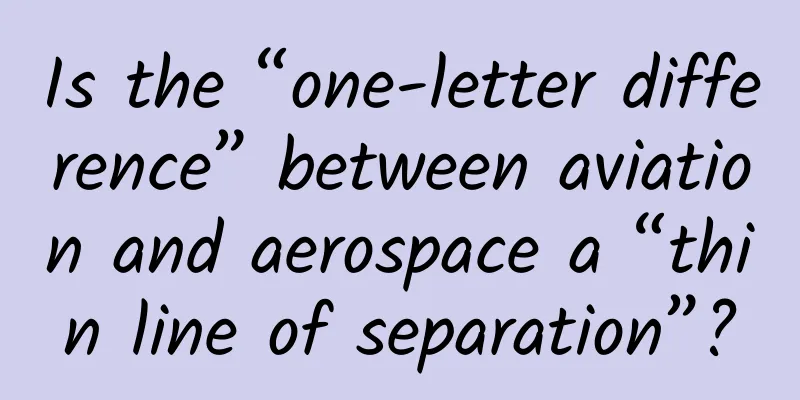Is the “one-letter difference” between aviation and aerospace a “thin line of separation”?

|
Are aviation and aerospace the same thing? This is a very interesting question. You must have discovered the characteristics of the two words "aviation" and "aerospace". They both have a "hang" character in front, which means flying; the characters after them are different, one is "kong" and the other is "tian". "Kong" refers to air, and "tian" refers to "space". Starting from these two characters, we can figure out the relationship between "aviation" and "aerospace". The earth we live on is surrounded by a thick atmosphere. The atmosphere is composed of air and is more than 1,000 kilometers above the ground. It is the existence of air that makes it possible for humans to realize their dream of flying like birds with the help of mechanical devices. This is the origin of "aviation". Then, based on "aviation", flying to higher altitudes, "spaceflight" was developed. Image source: Pixabay Human beings are not naturally suited to flying. It doesn't matter. As long as we have dreams and creativity, we can make "artificial wings" and fly, and we can fly higher and farther. Do you remember? I told you the story of two pairs of brothers before. More than 240 years ago, the Montgolfier brothers of France invented the hot air balloon; more than 120 years ago, the Wright brothers of the United States invented the airplane: With the help of aircraft, humans can fly into the sky. There are two major categories of aircraft: one is lighter than air, represented by balloons, and uses the buoyancy generated by air to rise into the air; the other is heavier than air, represented by airplanes, and uses the lift generated by flowing air to fly. From the ground upwards, as the altitude increases, the air becomes thinner and thinner, and it is difficult for all kinds of aircraft to continue flying. In order to fly higher, we need to use modern rockets, that is, launch vehicles. In 1903, the year when the Wright brothers invented the airplane, Tsiolkovsky of Russia published a paper "Using Jet Tools to Study Space", which proposed the concept of modern rockets and thrust calculation formulas. In 1926, Goddard of the United States built the world's first liquid-fuel rocket. In 1957, with the help of a launch vehicle, the Soviet Union launched the first artificial satellite. In 1961, Gagarin of the Soviet Union also used a launch vehicle to successfully enter the Earth's orbit on a spacecraft, and sailed around the Earth in 108 minutes, becoming the world's first astronaut. Since then, the aerospace industry has opened a new chapter. Now, humans have launched tens of thousands of satellites and hundreds of deep space probes. This is how the aviation and aerospace industries have developed step by step. After more than a hundred years of development, mankind's aviation and aerospace industries have made great achievements, and people have developed a variety of aircraft and spacecraft. We call aircraft and spacecraft aircraft, and different aircraft operate at different altitudes. But how to determine the height boundary between aviation and aerospace? Scientist von Karman, through theoretical calculations and practical verification, pointed out that at an altitude of 100 kilometers above the ground, aerodynamics fails and is replaced by orbital astronomy. In other words, when a spacecraft reaches a certain speed, it will not be sucked down by the earth's gravity, but can form a continuous orbital operation. This altitude should be defined as the dividing line between aviation and aerospace. This view was adopted by the world's aerospace industry, and this invisible boundary is also called the "Karman Line". Below the Karman Line is air space, which belongs to the airspace of each country, and the flight activities here belong to "aviation"; above the Karman Line, although there is still air, it is called space, which belongs to free space, and the flight activities here belong to "aerospace". Source: Chongqing Industry-University-Research Cooperation Promotion Association Author: Zhang Juen, Advisor to the Science and Technology Committee of the Aviation Industry Corporation of China Review expert: Mao Yi, chief expert of Chongqing Science Communication Expert Group, professor of Chongqing Electronic Engineering Vocational College Statement: Except for original content and special notes, some pictures are from the Internet. They are not for commercial purposes and are only used as popular science materials. The copyright belongs to the original authors. If there is any infringement, please contact us to delete them. |
>>: Fermentation gives yogurt its "magic", but probiotics may not have the "magic"
Recommend
How to plan an event? Activity planning process conception
1. Principles of activity task allocation 1) Spec...
Which day is better for sleeping? The national autumn cool sleeping map will help you unlock the best sleeping "position"
Do you remember how hard it was to fall asleep ev...
Shen Mengchen's first car for taking care of her baby, AION S MAX is available on the market starting at 149,900 yuan
In the past, when a man became a father, he would...
American TV series "Bones" all 12 seasons 246 episodes HD English subtitles collection
"Bones" is a forensic crime drama serie...
Marketing promotion methods | How to create private domain traffic?
Friends from different industries asked them how ...
How to do marketing if the budget is not enough?
We all know that how many people can be promoted ...
Three questions about knowledge payment: How to monetize? User retention? Content operation?
Wu Bingjian : I have invested in a knowledge paym...
Vue.js and MVVM small details
MVVM is the abbreviation of Model-View-ViewModel,...
Apple to launch new iPhone SE: Price in China starts at 2,999 yuan, with target of 30 million units shipped
Apple is ready to release the new iPhone SE, whic...
This fleshy worm knows the "gun fighting technique" in the "God Drama"
Recently, the sand dollar has become a hot topic ...
A practical guide to KOL marketing丨Winning strategies for brand marketing on Xiaohongshu
As media becomes increasingly fragmented and dive...
Apple now rejects app updates that ignore iOS 14.5 app tracking transparency rules
According to a new report from Forbes, Apple has ...
Polar bear sweater is as warm as down jacket, but only one-fifth the thickness!
Inspired by polar bear fur, the "black techn...
How to create a hit short video? What new ways to play?
Nowadays, short videos have become a new trend th...









